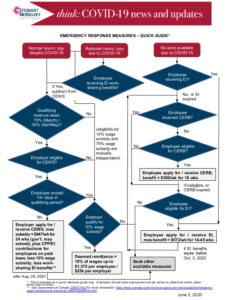Taking stock: Quick reference guide for government initiatives
*Flowchart below last updated June 2, 2020 (Originally published April 14, 2020)
With the passing of Bill C-14, the COVID-19 Emergency Response Act, No. 2 on April 11, 2020, the federal government has now laid a legislative foundation for various initiatives to assist employers and employees who are affected by COVID-19. The main measures include:
- The new Canada Emergency Response Benefit (“CERB”)
- The new Canada Emergency Wage Subsidy (“CEWS”), a 75% wage subsidy for eligible employers for the 12-week period beginning March 15, 2020
- The new 10% Temporary Wage Subsidy for employers
- Enhanced access to Employment Insurance (“EI”) benefits, including streamlining applications to the EI work-sharing program
Details on emergency response measures have shifted over the past few weeks, as they have evolved in response to our ever-changing situation. We expect this evolution will continue in many respects; notably, we are still awaiting regulations to further clarify some details related to CERB and CEWS.
However, given that the legislation now appears to be place, it seems an opportune moment for a fresh look at the current landscape of options. Recognizing it is a busy time, it is our pleasure to provide a dynamic summary of the mutual interactions between CERB, CEWS, EI and the 10% wage subsidy. We trust this will serve as a helpful reference point when seeking employment and tax advice to find the best options in the circumstances.
*Link to printable PDF version here.
This article is provided for general information only. If you have any questions about the above, please contact a member of our Labour and Employment group.
Click here to subscribe to Stewart McKelvey Thought Leadership articles and updates.
Archive
EDITOR’S COMMENT This edition of Atlantic Employers’ Counsel focuses on key areas of employment standards in Atlantic Canada. Employment standards legislation outlines the rights and obligations of employees and requirements that apply to employers in…
Read MoreNEW TORT OF CYBERBULLYING On May 10, 2013 the Nova Scotia legislature passed the Cyber-safety Act (Bill 61). When this bill comes into force, it will give rise to a new tort of cyberbullying that…
Read MoreGOVERNMENT ACTION In the Economic Action Plan 2010, the Harper Government committed to bring greater clarity to how mortgage prepayment penalties were calculated. As part of the commitment, on February 26, 2013 the government released…
Read MoreSTEWART MCKELVEY WELCOMES BACK WANDA DOIRON AS MANAGER, CORPORATE SERVICES – NOVA SCOTIA You might remember Wanda from her time in our Corporate Services group from 2002 to 2008. Since then, she has worked in-house…
Read MoreREASONABLE PEOPLE DOING QUESTIONABLE THINGS: CONFLICTS OF INTEREST AND JUST CAUSE Can a unionized employee moonlight in his off hours to earn some extra money by doing the same work he does for his daytime…
Read MoreStewart McKelvey’s Vision Improving Legal Analysis (SVILA*) is an e-discovery project and litigation management tool. For more information on our e-discovery services, download the SVILA e-discovery document.
Read MoreIN THIS ISSUE: A New Brunswick business lawyer’s perspective by Peter Klohn Why Canada’s immigration rules matter to your business by Andrea Baldwin Financing Energy Projects during the Project Lifecycle by Lydia Bugden, Colm St. Roch Seviour and Tauna Staniland Download…
Read MoreYellow diamonds in the light And we’re standing side by side As your shadow crosses mine What it takes to come alive It’s the way I’m feeling I just can’t deny But I’ve gotta let…
Read MoreINTRODUCTION On December 6, 2012, The Nova Scotia Department of Environment (NSE) released Draft Ministerial Protocols (the “Draft Protocols”) related to contaminated sites. The release of the Draft Protocols has been eagerly anticipated. The adoption…
Read MoreRecent changes to the Rules of the Supreme Court, 1986, SNL 1986, c 42, Sch D On December 14, 2012, several changes were made to the Rules of the Supreme Court. These changes include: who may act…
Read More
